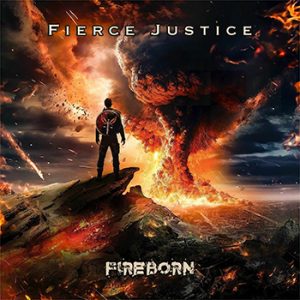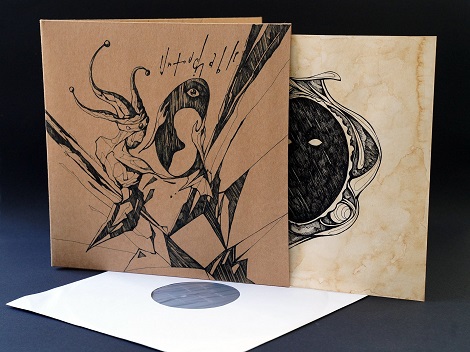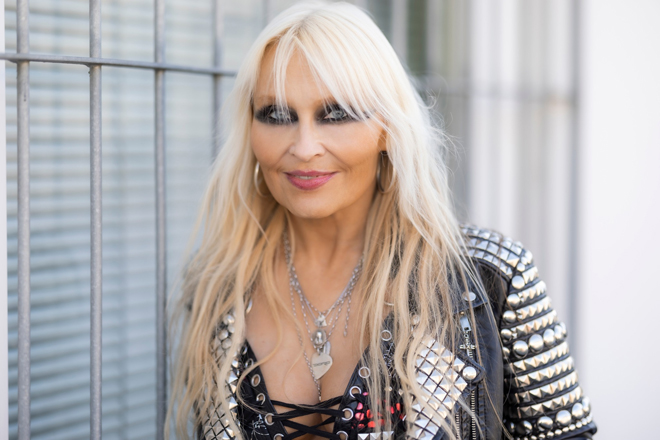MIDGARDSBLOT 2019 (Horten, Norway)
August 15-17, 2019
by Jorge Patacas
The fifth edition of Midgardsblot was held last August. This is a festival that has been growing year by year thanks to the constant work of the managers and volunteers. There is an aspect that distinguishes it from the rest of the European summer festivals, which is the concept, since music and history centered on the Viking period coexist perfectly through shows, DJ sets, seminars, guided walks, thematic games, Viking market and all kind of activities related in one way or another with the medieval world. For making this happen, the organization chose the perfect location in the town of Borre, Horten, approximately 90 km away. south of Oslo. There is a large park (182,000 m²) where Borre’s mounds can be found, this area is considered one of the main cultural heritage of the country. It was active between the years 600 and 900, having a leading role in Viking history. A few meters away is the Midgard Viking Center, where you can see interesting exhibits that show different aspects of the history, as well as activities for kids. It is a place that undoubtedly attracts both locals and foreigners who come to these Nordic lands to live an unforgettable experience. Many choose to camp on the site during the days of the event, and there are three areas for it. There’s an area which is exclusive for volunteers, another one for those who choose outfits and tents according to the medieval era, and then there is the general campsite, which is located approximately fifteen minutes away from the festival area, crossing the park with the mounds mentioned above, by the sea. There when it gets cold at night, a bonfire is lit and it becomes the best environment for long talks between people from different parts of the world, in addition to people singing traditional songs such as “Herr Mannelig”, the Swedish ballad that has been covered many times by bands from different genres. Unforgettable memories.
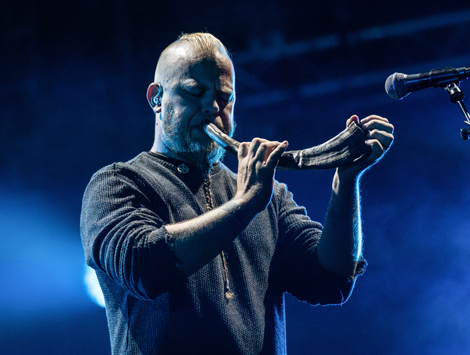
In the same area, during the morning, there is a race of inflatable unicorns in the sea, which is definitely very fun to watch.
But something that is undoubtedly a must see are the seminars held at the aforementioned Midgard Viking Center, presented by Vicky Mikalsen, who is a board member of the festival. These were called Mimir Talks, since Mimir is one of the important figures in Norse mythology, renowned for his knowledge and wisdom. Upon entering the room where the talks were held, we could see an illustration of Mimir created by the French artist David Thièrrèe, who has worked with bands such as Behemoth, Gorgoroth, Enslaved, among others.
Personally, one of the seminars that most aroused my interest was that of the British author Dayal Patterson, who has written for magazines such as Decibel, Terrorizer and Metal Hammer, and now owns the publishing company Cult Never Dies, for which he has released a number of books related to metal with amazing content, including the series dedicated to Black Metal that began with the renowned “Black Metal: Evolution of the Cult”, published in 2013.
In his presentation, Patterson discussed this book, explaining its approach, which is very different from other publications on the genre that focus more on the well-known facts of the early 90’s. Among other aspects, he talked about the importance of tape trading at the time when the genre emerged, long before the Internet was a thing, and this helped the mysticism surrounding the pictures and music, something that it would not have happened in the same way these days where many musicians post even what they had for dinner on social media.
Through Cult Never Dies, Dayal has also published books on different fanzines that were essential in the development of the genre, retrieving interviews originally published at that time. Among his most recent publications are the official biography of Rotting Christ, written together with the band’s vocalist, Sakis Tolis, and another one about the Portuguese act Moonspell.

A few minutes later, the room was packed, since the next one on the program was the talented Einar Selvik (Wardruna, ex Gorgoroth), who was originally going to give a seminar with Ivar Bjørnson (Enslaved) about the concept of Skuggsjá and Hugsjá, on which their project is based. Unfortunately, Bjørnson was at the airport and could not arrive on time, so Selvik decided to change the topic of the seminar and talked about the instruments used in his projects and their history, showing us how each one sounds and even singing a capella, getting loud applause and leaving many of us speechless with his incredible voice. By the end, the audience had the opportunity to ask a few interesting questions. It was a real pleasure to have attended the seminar of the man who also worked on the soundtrack for the well-known History Channel TV show Vikings, appearing as an actor as well.
The festival site opened to the public around 4 pm, and there you could take a look at the merchandising, have some food or drink, until the access to the main area with the stages was authorized, which happened some minutes later.
Upon entering this area we could find more food and drink stalls, the largest stage called Valhalla and a secondary stage located inside the Gildehallen, a reconstruction of a Viking party hall opened in 2003, which is really incredible.
Exactly in the area that separates Gildehallen from Valhalla, the Blot Ceremony was performed, this is kind of an opening ritual of the event, performed by Folket Bortafor Nordavinden, who give honor to the ancient gods through percussion, throat singing and lots of humor, shouting the traditional “Skål!” while toasting together with the audience.
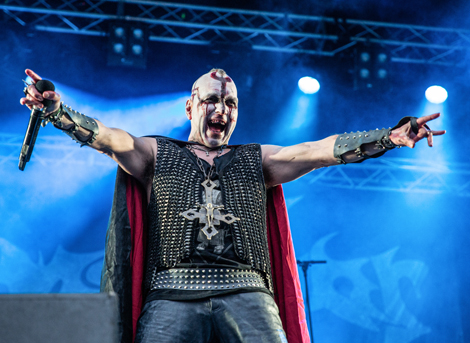
Thus they established the perfect atmosphere for the beginning of the activities that began with Gaahls Wyrd concert on the main stage. Gaahl has been active on the Black Metal scene since 1993, being one of the founders of Trelldom, later recognized internationally when becoming the vocalist for Gorgoroth, which he has been part of for almost a decade. He has also participated in other projects such as Wardruna, God Seed (along with King ov Hell), and is currently involved with this new project, with which he released his debut album “GastiR – Ghosts Invited” this year. He played some songs from this record, but there was also room for older stuff from his previous bands like “Prosperity and Beauty” by Gorgoroth, for example.
The legendary Hungarian black metallers Tormentor are one of those bands hard to see very often, so it was a special occasion to be there. They formed in 1985 and only recorded a couple of demos before splitting up in 1991, after which their vocalist Attila Csihar would become part of Mayhem two years later. The band released their only album to date, “Recipe Ferrum! 777” in 2000, but they are still mostly well-known for their “Anno Domini” demo of 1989, and that is why since their reunion in 2017, there are always songs of that album on their set. And this time was no exception, so they played songs such as “Elisabeth Bathory”, “Beyond”, “In Gate of Hell” and “Apocalypse”, to name a few.
The Gildehallen stage was then opened with the teenage duo Golden Core, who started their career in 2014, playing their first concert when they were 12 and 10 years old. Today, five years later, they have signed a contract with the Norwegian label Fysisk Format, won a local competition that allowed them to play at the Bloodstock Festival in England, and people get impressed by their fusion of styles where Stoner and Doom stand out as their main influences. You can listen to their material on their Bandcamp site, but if you have the chance to see them live, do it because it’s worth it.
One of the most expected shows on the first day was that of the duo composed by Ivar Bjørnson and Einar Selvik, and the expectations were definitely met. Accompanied by top-level musicians, they played part of their masterpieces “Hugsjá” and “Skuggsjá”, before a crowd that got thrilled with each of the compositions, some of us got goosebumps at some point. Selvik explained the concept behind some of the songs, made the audience laugh at other times and was responsible for getting the right climate for each tune.
Interesting story, the project began as a commissioned musical work in commemoration of the 200th Anniversary of the Norwegian constitution, a concert that was held at the Eidsivablot Festival in Eidsvoll, Norway, on September 13, 2014. Fortunately, they decided to move on after that special event.
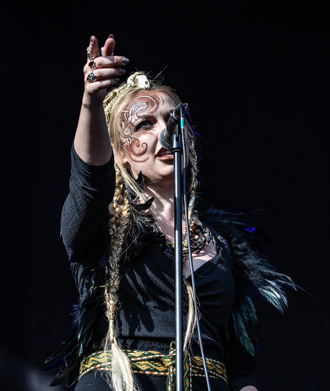
A third stage called Kaupangr, of much smaller dimensions, was located in one of the tents selling beverages, and mostly folk bands and solo artists performed there, including Fylgja, Seidrblot and Sindri, who is also a member of a band called Endrborinn. Metal Yoga was also held here, where instructor Saskia Thode explains the different yoga positions with a guttural voice, while heavy riffs sound on the background.
On the second day, the festival area was opened earlier, at 2:00 p.m., with the Tønsberg-based alternative band Synthetic Gentlemen being the first one to go on the main stage.
Voluspá is another band that one can only see in Scandinavia as of now. Their name comes from the first poem of the Poetic Edda, and tells the story of the creation of the world and its coming end, related to the audience by a völva (seeress) addressing Odin. The Folk Rock quartet was formed by vocalist Sól Geirsdóttir (also known as The Viking Queen) and bassist Stefan Roke. With a strong influence of the Viking era, they performed an acoustic set that captivated the audience with a sound that allowed us to distinguish every detail. The wonderful voice of Geirsdóttir fits perfectly with the female choirs by Hilde Stenersen and male choirs by Varg Saastad, who also plays guitar and other traditional instruments. What they did in songs like “Heathen Heart” will remain in our memory forever.
Less than two months after their performance at Tons of Rock festival, Vreid (Wrath, in Norwegian) played at Midgardsblot with their particular melodic approach to Black Metal. The group was formed in 2004 by three former members of the amazing Windir, after the passing of vocalist Valfar. In 2010 they were joined by another former Windir member, Strom, replacing their first guitarist Ese, and thus the connection with the never forgotten Sogndal band is even greater today. In fact, they played “Journey to the End”, the last song on Windir’s “1184” acclaimed album released in 2001, while “Lifehunger”, “One Hundred Years” and “Pitch Black” stood out when it comes to their own songs.
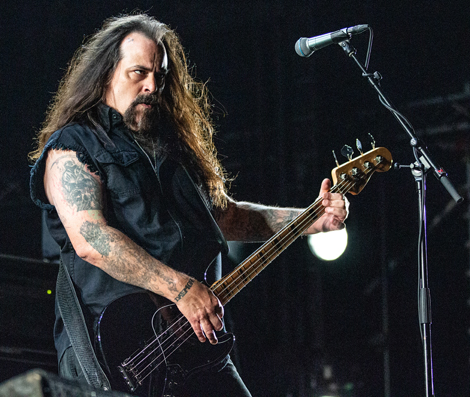
If you don’t live in Scandinavia, the name Gåte probably does not sound familiar to you, but they have many fans in their home country, so the announcement of their inclusion in the festival clearly attracted more people, and that was proved during that evening.
Gåte (Riddler, in Norwegian) was formed in 1999 in Trondheim, Norway, and they are usually labeled as Folk Rock, and although it is true that they have clear influences from that genre, it is also clear that there are progressive and alternative nuances and even some electronic elements here and there. When it comes to the show, when one sees the guitar player Magnus Børmark climbing a pile of amplifiers, the violinist/keyboardist Sveinung Sundli crowdsurfing and the vocalist Gunnhild Sundli moving around the stage, it’s easy to forget the Folk Rock label. Very good show!
Deicide, the death metallers from Tampa, Florida, took over the stage a while later with the legends Glen Benton on bass and vocals and Steve Asheim on drums, and a line up completed by Kevin Quirion and the recently joined member Chris Cannella on guitars. This year the band is celebrating its 30th Anniversary with the name Deicide (they were called Amon between 1987 and 1989), so the setlist featured stuff from most of their albums. With the band’s logo on the backdrop, they showed how to make good Death Metal, playing one song after another almost breathlessly. “Dead By Dawn”, “Serpents of the Light”, “Once Upon the Cross”, “Homage for Satan”, “Scars of the Crucifix”… it is difficult not to do headbanging with these brutal sounding classics. Benton is already 52 years old and Asheim is 49, but they seem to have the energy to be on the road for a long time and that’s good news for old-school Death Metal fans.
The third and final day of the festival began with very bad weather conditions, including rains and strong winds of more than 10 m/s, so there were some difficulties during the morning and early hours of the afternoon, so thanks to the crew for their help and support at all times while the storm lasted.

For this reason, the beginning of the day’s activities had a delay of about an hour, with the Grindcore band Whip performance being affected, so they ended up playing an exclusive show for those who worked for the festival, while part of the rest of the program suffered some modifications. Fortunately, everything went back to normal, once the weather improved.
Upon reaching the main area, the Swedes Ereb Altor were starting their show. On the eve of the release of their eighth studio album “Järtecken”, the Gävle-based outfit performed a setlist that was made up of songs from all their career, while raindrops were still falling on Borre’s soil.
I remember hearing the Norwegian outfit Einherjer for the first time with their second album “Odin Owns Ye All” from 1998. Twenty years later, I had the opportunity to see them for the first time and in their home country, and the wait was worth it. Even if the band was inactive for a period during the past decade and there are only two original members left, the band has not lost their quality and a festival like Midgardsblot seemed to be perfect for them, considering that their Viking-themed lyrics. In fact, there was a group of people dressed as medieval soldiers in the audience, and they even started a mini moshpit.
After the Einherjer show, there was another Norwegian band playing at Gildehallen, in a completely different style. Attan is a quintet from Oslo that knows how to put on a very intense show, and the stage they were playing suited them perfectly. Not because of the Vikings, since they have nothing to do with that, but because of the intimacy of the show. A band who has roots in Hardcore is undoubtedly much more enjoyable in small places, and even more if they also have influences from Sludge and some Black. A visceral, chaotic show, enjoyable from beginning to end.
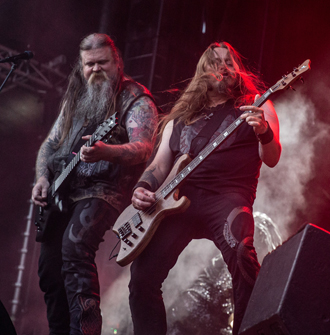
Coming back to the main stage, the legendary Enslaved performed a concert based on the myths surrounding a new consciousness born from chaos and order in kinship. For this they also had the cooperation of the contemporary dance company Mia Habib Productions, which was a surprise to the audience, since it’s not something that is usually seen in an extreme metal show. Enslaved has changed a lot from his initial Viking-themed Black Metal to their more progressive stuff from today, and that can be noticed in their setlist when they alternate songs from different eras such as “Ethica Odini”, “Return to Yggdrasil” or “Havenless”. The visual show of the dance group fit very well with the band, putting together a brilliant performance.
The most expected band of the day without a doubt was Heilung with their unique and inimitable style, both visually and musically. A stage where nature has a leading role, welcomes a group of girls who form a circle to begin the ritual.
Heilung means “Healing” in German and the name is very accurate, since the band invites us to a long journey towards ourselves, to be aware of our own senses by immersing ourselves in a state of relaxation while recreating periods of history as the Viking era (of course) and the Iron Age. To achieve this, they use all kinds of instruments and objects, throat singing by Kai Uwe Faust and the ethereal voice of Maria Franz that has kind of a hypnotic effect on the crowd and is accompanied by a female choir at times. Watching them live is a unique experience in which one is caught by every sound and every movement.
A new Midgardsblot edition came to an end, and there was a growth compared to previous years, according to the promoters and attendees. Viking-themed music, history and culture coexisted once again in a nice environment, so if you live in Norway or plan to travel to Norway during the next European summer, do not hesitate to attend this event. Tickets for the 2020 edition are now on sale!
All Photos by © Christin Hansen


